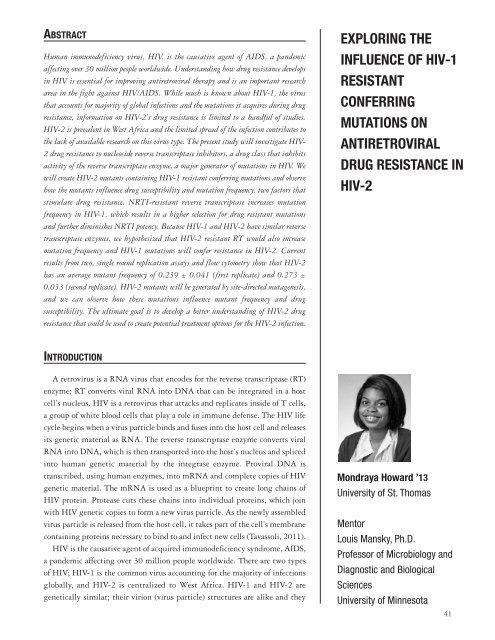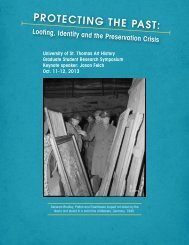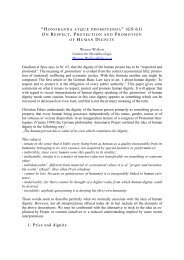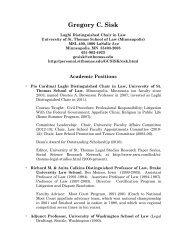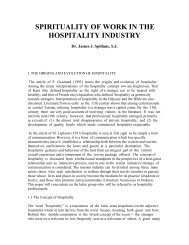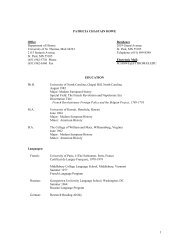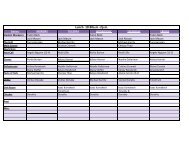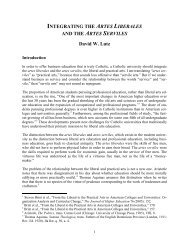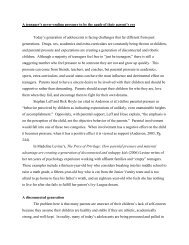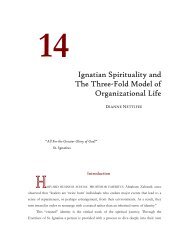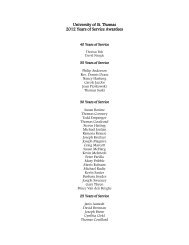dr. ronald e. mcnair acknowledgements - University of St. Thomas
dr. ronald e. mcnair acknowledgements - University of St. Thomas
dr. ronald e. mcnair acknowledgements - University of St. Thomas
Create successful ePaper yourself
Turn your PDF publications into a flip-book with our unique Google optimized e-Paper software.
ABSTRACT<br />
Human immunodeficiency virus, HIV, is the causative agent <strong>of</strong> AIDS, a pandemic<br />
affecting over 30 million people worldwide. Understanding how <strong>dr</strong>ug resistance develops<br />
in HIV is essential for improving antiretroviral therapy and is an important research<br />
area in the fight against HIV/AIDS. While much is known about HIV-1, the virus<br />
that accounts for majority <strong>of</strong> global infections and the mutations it acquires during <strong>dr</strong>ug<br />
resistance, information on HIV-2’s <strong>dr</strong>ug resistance is limited to a handful <strong>of</strong> studies.<br />
HIV-2 is prevalent in West Africa and the limited spread <strong>of</strong> the infection contributes to<br />
the lack <strong>of</strong> available research on this virus type. The present study will investigate HIV-<br />
2 <strong>dr</strong>ug resistance to nucleoside reverse transcriptase inhibitors, a <strong>dr</strong>ug class that inhibits<br />
activity <strong>of</strong> the reverse transcriptase enzyme, a major generator <strong>of</strong> mutations in HIV. We<br />
will create HIV-2 mutants containing HIV-1 resistant conferring mutations and observe<br />
how the mutants influence <strong>dr</strong>ug susceptibility and mutation frequency, two factors that<br />
stimulate <strong>dr</strong>ug resistance. NRTI-resistant reverse transcriptase increases mutation<br />
frequency in HIV-1, which results in a higher selection for <strong>dr</strong>ug resistant mutations<br />
and further diminishes NRTI potency. Because HIV-1 and HIV-2 have similar reverse<br />
transcriptase enzymes, we hypothesized that HIV-2 resistant RT would also increase<br />
mutation frequency and HIV-1 mutations will confer resistance in HIV-2. Current<br />
results from two, single round replication assays and flow cytometry show that HIV-2<br />
has an average mutant frequency <strong>of</strong> 0.239 ± 0.041 (first replicate) and 0.273 ±<br />
0.033 (second replicate). HIV-2 mutants will be generated by site-directed mutagenesis,<br />
and we can observe how these mutations influence mutant frequency and <strong>dr</strong>ug<br />
susceptibility. The ultimate goal is to develop a better understanding <strong>of</strong> HIV-2 <strong>dr</strong>ug<br />
resistance that could be used to create potential treatment options for the HIV-2 infection.<br />
INTRODUCTION<br />
A retrovirus is a RNA virus that encodes for the reverse transcriptase (RT)<br />
enzyme; RT converts viral RNA into DNA that can be integrated in a host<br />
cell’s nucleus. HIV is a retrovirus that attacks and replicates inside <strong>of</strong> T cells,<br />
a group <strong>of</strong> white blood cells that play a role in immune defense. The HIV life<br />
cycle begins when a virus particle binds and fuses into the host cell and releases<br />
its genetic material as RNA. The reverse transcriptase enzyme converts viral<br />
RNA into DNA, which is then transported into the host’s nucleus and spliced<br />
into human genetic material by the integrase enzyme. Proviral DNA is<br />
transcribed, using human enzymes, into mRNA and complete copies <strong>of</strong> HIV<br />
genetic material. The mRNA is used as a blueprint to create long chains <strong>of</strong><br />
HIV protein. Protease cuts these chains into individual proteins, which join<br />
with HIV genetic copies to form a new virus particle. As the newly assembled<br />
virus particle is released from the host cell, it takes part <strong>of</strong> the cell’s membrane<br />
containing proteins necessary to bind to and infect new cells (Tavassoli, 2011).<br />
HIV is the causative agent <strong>of</strong> acquired immunodeficiency syn<strong>dr</strong>ome, AIDS,<br />
a pandemic affecting over 30 million people worldwide. There are two types<br />
<strong>of</strong> HIV; HIV-1 is the common virus accounting for the majority <strong>of</strong> infections<br />
globally, and HIV-2 is centralized to West Africa. HIV-1 and HIV-2 are<br />
genetically similar; their virion (virus particle) structures are alike and they<br />
EXPLORING THE<br />
INFLUENCE OF HIV-1<br />
RESISTANT<br />
CONFERRING<br />
MUTATIONS ON<br />
ANTIRETROVIRAL<br />
DRUG RESISTANCE IN<br />
HIV-2<br />
Mon<strong>dr</strong>aya Howard ’13<br />
<strong>University</strong> <strong>of</strong> <strong>St</strong>. <strong>Thomas</strong><br />
Mentor<br />
Louis Mansky, Ph.D.<br />
Pr<strong>of</strong>essor <strong>of</strong> Microbiology and<br />
Diagnostic and Biological<br />
Sciences<br />
<strong>University</strong> <strong>of</strong> Minnesota<br />
41


